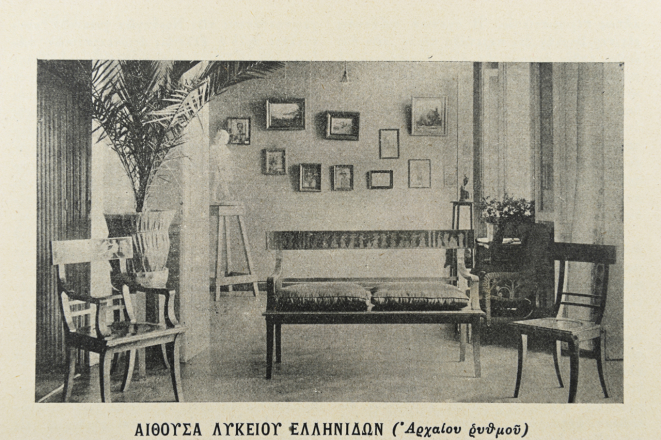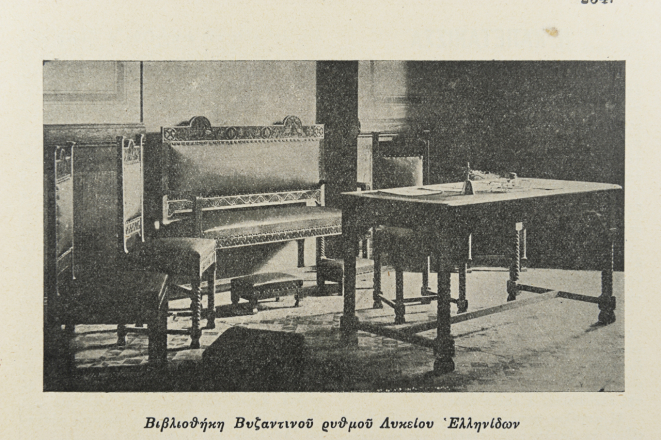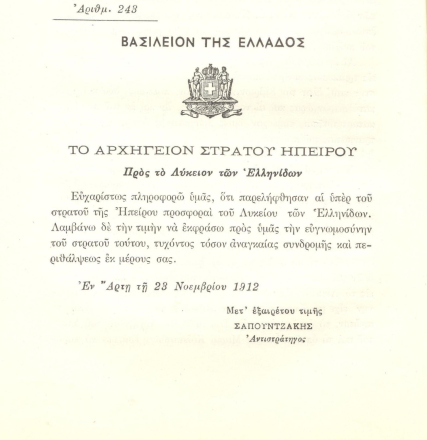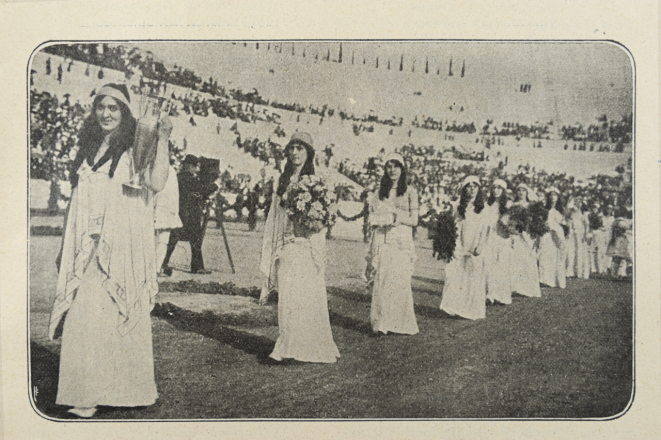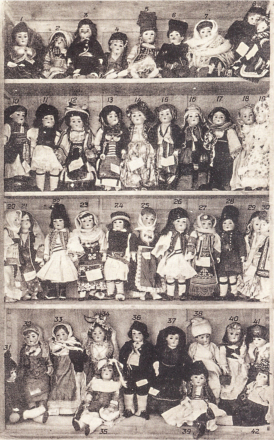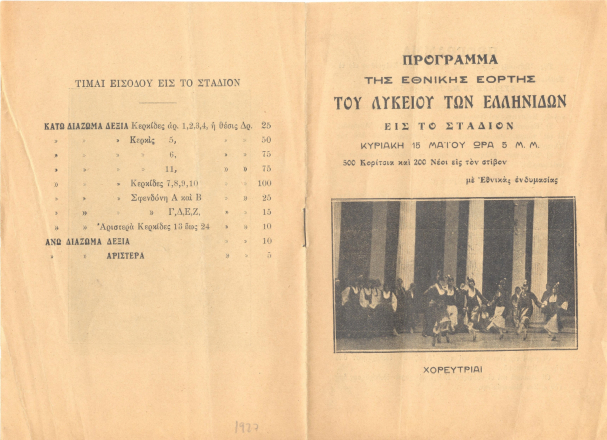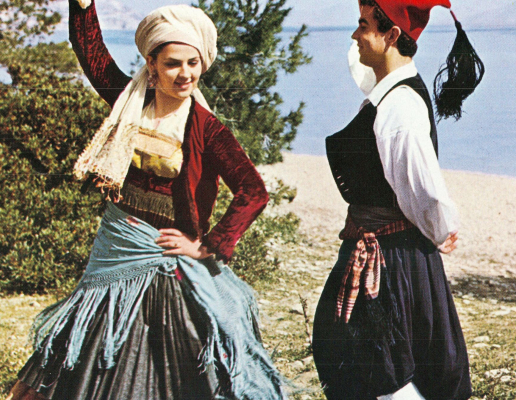1911-1930
The Court of the First Instance in Athens approved the LtE’s Charter on 19th February 1911 (published in the Government Gazette on 2nd March).
A committee was formed by musicians A. Samaras, M. Kalomiris, G. Labelet, G. Lavragas and D. Lialios, representatives of what was known as the “National School”, to provide musical arrangements of Greek dances.
First public appearance by the LtE, with the production of the “Anthestiria” celebration at the Zappeion on Mayday. The event was repeated at the Municipal Theatre on 5th May.
Opening of the LtE headquarters at 4 Othonos Street. Two library and reading rooms, one in “archaic style” and one in “Byzantine style”, a “contemporary Greek room for the Dance Section”, and a “tea room” were created in the space. The whole building was furnished under the supervision of the Art Section in collaboration with architect Ernst Ziller and Byzantinologists A. Zachos and A. Adamantiou.
New Year’s celebrations at the Municipal Theatre on 6th January, with the traditional cutting of the Vasilopita, and a performance of dances and tableaux vivants, including “the ladies of the Court of Queen Amalia”.
As part of the LtE’s varied action after the start of the First Balkan War in October, a Section was formed with the aim of providing work to the wives of conscripts. In addition, the Science department collaborated with the Hygiene and Nursing department of the Greek Women’s Union to create a training programme for wartime nurses. The Lykeion used membership donations to organise a 40-bed hospital for the front in Epirus.
Art exhibitions were held with paintings inspired by the Balkan Wars, by Thalia Flora-Karavia and Nikolaos Ferekides.
Musicians Kalomiris, Psachos, and Kaisaris provided arrangements of 9 Greek dances for the LtE.
Dance lessons taught by Haralampos Sakellariou were organised in the Lykeion ton Ellinidon’s space.
Winter event by the LtE at the Royal Theatre, with tableaux vivants inspired by the three periods of Hellenic history: ancient (Nike), Byzantine (Byzantine crown), and modern (integration of new “countries” after the Balkan Wars).
Music and dance show produced in April at the “Achilleon” in Kerkyra, in honour of Kaiser Wilhelm.
First “Festival of the Stadium” organised at the Panathinaikon Stadium on 27th April. The Festival became a regular fixture in the 1920s and was, for many years, the LtE’s most important event.
The first catalogue of objects was set up, and they became the core of the LtE’s costume collection.
Queen Olga donated her collection of porcelain dolls in regional costumes to the LtE.
Winter show at the Royal Theatre, with tableaux vivants titled “The Korai of the Acropolis” and “Byzantine procession”, overseen by Eleni Georganti, another titled “The Little Sage”, based on a painting by Gyzis, and Hellenic dances (23rd and 27th March).
Show at the Stadium, on 21st May, “for the nameday of the King”, with the participation of the Band of the Athenian Guards.
Festival at the Zappeion on April 9th.
Callirrhoe Parren was exiled to the island of Hydra along with agents of the anti-Venizelos camp (January 1918-November 1919). Operation of all the sections of the LtE was suspended, with the exception of the Dance Section.
The LtE participated in the nursing care efforts after Greece entered World War I. Among other things, they delivered 40 beds to the Hellenic Red Cross and produced woollen goods.
The LtE premises moved to a building on the corner of Amalias Avenue and 1 Periandrou Street (the Makka residence).
Participation in the Greek Exhibition in Paris with dolls created at the Lykeion and with five traditional costumes.
The first four issues of the Bulletin of the LtE were published.
The LtE submitted a memorandum to Parliament on the position of women (regarding private and public law and citizen rights).
The “annual Hellenic festival of the Lykeion” took place at the Municipal theatre on 10th May. The programme included a recitation by Marika Kotopouli, Greek dances and songs, a “Byzantine mural” and a “procession of Caryatids and Peplos Korai (Peploforoi)”.
The second Artisan Exhibition tοοκ place. “The Lykeion ton Ellinidon, consistent in its programme of spreading the authentic culture of Greece into our society, our habits, and our lives, opened its doors two days ago to an exhibition of the artistic craft skills of Greek women”.
On 10th September 1922, the LtE called its members to an extraordinary General Assembly for a “serious reason”. Three days later, the newspaper “Athinaiki” published the outcome of a collection taken up by the LtE (a total of 5,465 drachmas).
The LtE offered multifaceted support to refugees following the Asia Minor Disaster, by organising soup kitchens, providing a room where clothes could be sewn, and looking after orphaned children.
The Homekeeping and Trade School, which was founded in 1897 by the Greek Women’s Union, was annexed to the LtE.
The LtE undertοοκ widespread social action. The Social Support Section created a workshop for refugees, and the Mothers and Educators Section opened a Sunday School and a public library.
The festival of the LtE took place at the Stadium once more, after the 1914 event. At this event, “rhythmic dances” in an ancient Hellenic style, taught by Marie Raymond, were performed for the first time.
Honorary diploma received at the International Exhibition of Modern Decorative and Industrial Arts (Exposition internationale des Arts décoratifs et industriels modernes) in Paris.
The LtE held a Greek Women’s Exhibition of Arts and Crafts, with paintings and handicrafts, as part of the Conference of the Women’s Petite Entente, which was formed in 1922 by women’s organisations in Greece, Bulgaria, Yugoslavia, Poland, Romania and Czechoslovakia (6th-13th December).
The largest and most financially successful festival was held at the Stadium. Members of the LtE took part, dressed as Minoan women, Amazons, Oceanids, Hestiads, Byzantine princesses, and peasants from regions of contemporary Greece.
The LtE hosted the first exhibition of folk crafts by Florentini Skouloudi-Kaloutsi’s workshop “Diplous Pelekys” (Double Axe).
Festival at the Stadium on 15th May, with the participation of 500 young women and 200 young men in ethnic dress.
The LtE participated in the second Thessaloniki International Fair, and received “the gold prize for its embroidered handicrafts”.
Event at the Royal Theatre to celebrate the centenary of the naval battle at Navarino.
Festival at the Stadium on 19th May.
The first celebration of Mothers’ Day in Greece was organised by the Mothers and Educators Section of the LtE on 2nd December 1929. As of the following year, the celebration took place on 2nd February.
As part of the LtE’s participation in celebrating the centenary from the formation of the Greek state, a recreation of the Greek Revolution was presented at the Panathinaikon Stadium on 6th April.
ID cards for LtE members were instated.

















